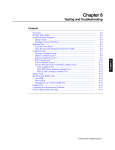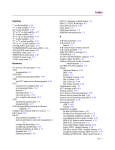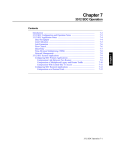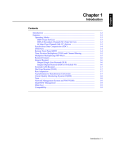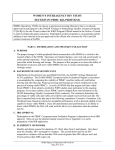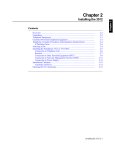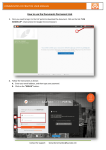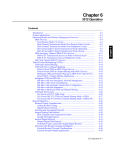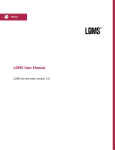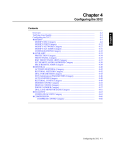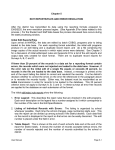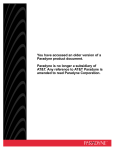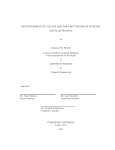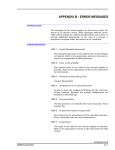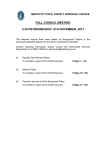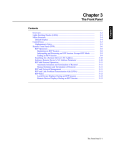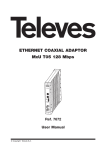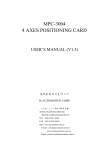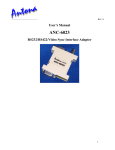Download Tran:3512 DSU/CSU User`s Manual:Ch9:DualVIEW
Transcript
Chapter 9 DualVIEW Overview ....................................................................................................... DualVIEW Operation: LPDA-2 and the Motorola Control Channel ....... Network Topologies ................................................................................. Preparing to Use the DualVIEW Management Feature ............................ DSU/CSU Management from NetView ................................................... Diagnostic Commands ............................................................................. Restoral Commands ................................................................................. Netview Monitoring and Testing .................................................................. Modem and Line Status (MLS)................................................................. Unsolicited MLS Command...................................................................... Solicited MLS Command.......................................................................... Digital MLS Panel (Page 1 of 3) ............................................................... Digital MLS Panel (Page 2 of 3) .............................................................. Digital MLS Panel (Page 3 of 3) .............................................................. Transmit and Receive (TRT) Test ............................................................. Using Modem Control (MDMCNTL)....................................................... MDMCNTL Syntax and Description ................................................... Modifying the Network Control Program (NCP).......................................... System Configuration ................................................................................... 9-2 9-2 9-3 9-4 9-4 9-5 9-5 9-6 9-6 9-6 9-6 9-7 9-9 9-11 9-13 9-15 9-15 9-17 9-17 DualVIEW 9-1 Chapter 9 Contents Overview The DualVIEW management feature lets you control 3512 DSU/CSUs from: • IBM's NetView • A Motorola 9800 or 9300 Network Management System (NMS) • Both concurrently From NetView, you can test and monitor a standard set of DSU/CSU parameters. DualVIEW is not available with 64k CC service. DualVIEW Operation: LPDA-2 and the Motorola Control Channel Link Problem Determination Aid, Revision 2 (LPDA-2) is the communications protocol used between host-based NetView software and transmission devices for exchanging diagnostic and control information. When a NetView operator issues a device-related command, NetView constructs a packet and routes it (through VTAM at the host computer) to the Network Control Program (NCP) at the front-end processor (Figure 9-1). The NCP creates an LPDA-2 command, suspends user data transmission on the main channel (without disrupting sessions), and sends the LPDA-2 command out on the appropriate line. IBM LPDA-2 Protocol NetView Host (VTAM) FEP (NCP) Motorola Management Protocol Local 3512 Motorola Management Protocol Remote 3512 Control Channel DTE Motorola NMS Figure 9-1. Network Management Command Flow The local transmission device recognizes the LPDA-2 command and matches the address in it with the device's assigned NetView address. The local device converts the LPDA-2 command to Motorola's proprietary network management protocol and sends a command to the remote 3512. The remote 3512 answers with a response formatted in Motorola's network management protocol, which the local device converts to LPDA-2 and forwards, by way of the NCP, to NetView. When NetView's command/response sequence is completed, user data transmission continues. A 3512 only responds to NetView or Motorola NMS commands; it does not send unsolicited data. In contrast, both management systems send unsolicited polls. 9-2 DualVIEW Network Topologies Figure 9-2 shows a typical point-to-point configuration with two transmission devices managed independently by a NetView host and a Motorola NMS. Commands Responses Primary NetView Host (VTAM) FEP (NCP) Secondary Local 3512 Remote 3512 Motorola Management Protocol Control Channel DTE Motorola NMS Figure 9-2. Dual-Managed Point-to-Point Configuration The Point-to-Point Device that is... NetView Identifies as... Closer to host More remote from host Primary Secondary The primary device receives NetView commands directly from the front-end processor (FEP). The secondary device receives them from the local device. Use NV Ports to select port(s) on which to receive NetView commands. Figure 9-3 shows a multipoint configuration with NetView and NMS management. Tributaries Control NetView Host (VTAM) FEP (NCP) 3512 Motorola Management Protocol Control Channel 3512 3512 3512 DTE DTE DTE Motorola NMS Figure 9-3. Dual-Managed Multipoint Configuration The Multipoint Device(s) that is... NetView Identifies as... Closest to host Remote from host Control Tributaries The flow of control is the same as for the point-to-point configuration above. DualVIEW 9-3 Dual Management mode allows for concurrent management from NetView and an NMS. The devices respond to commands issued from either manager on a first-come first-served basis. However, the NMS is the dominant system: With... NMS The Operator Can... Configure and monitor the device Monitor line status NetView Initiate tests Monitor the device Monitor line status Initiate tests In a DDS-II SC network: • LPDA is not supported on 3512s are managed by a Motorola NMS with DTE Con=Muxed • LPDA is supported on 3512s without NMS management (regardless of the DTE Con option) Preparing to Use the DualVIEW Management Feature Initially, the DualVIEW feature must be configured from the 3512 front panel. Chapter 4 describes DualVIEW front panel parameters. It may also be necessary to modify the NCP at the IBM host site to support the LPDA-2 management protocol and tail circuits for second-tier lines. See “Modifying the Network Control Program” at the end of this chapter. SDC only NOTE: DualView is not available on the 3512 SDC Port 3 when P3=Compress. DSU/CSU Management from NetView NetView supports the Modem Control (MDMCNTL) command, to initiate and terminate restoral; and the Modem and Line Status (MLS) and Transmit and Receive Test (TRT) diagnostic commands, for DSU/CSU and line management. MLS and TRT are part of the Network Problem Determination Application (NPDA) Test command. NPDA is also known as Hardware Monitor. NPDA collects and stores data from physical resources in the network and issues alerts about problems. 9-4 DualVIEW Diagnostic Commands From NPDA, the NetView operator can monitor transmission devices, DSU/CSUs, and line conditions in the network. NPDA commands are channel-specific: in a multiplexed environment, each channel responds to NPDA commands independently. Speed and EIA readings are reported on the port under test. The MLS command lets you diagnose hardware errors and monitor remote EIA status. When MLS is initiated by the NetView operator, it is solicited; when initiated by the FEP, it is unsolicited. MLS is similar to the Motorola NMS EIA Status Report. If the device is configured for channel sharing, EIA status can be reported for each port based on its address. The remote address sent by NetView must match the highest six bits of the remote device's station address. The address’s lowest bits indicate the shared port, as follows: Address’s Lowest Bits Port 00 01 10 11 1 2 3 4 The TRT command initiates a block error test that helps diagnose transmission problems. TRT is similar to the NMS or 3512 BER test. NOTE: The TRT command interrupts TDM channels in a multiplexed environment. Restoral Commands From NetView’s Network Communications Control Facility (NCCF), you can issue modem control commands. The commands can enter the 3512 through any port that carries NetView traffic. The MDMCNTL command manages restoral operation. You can initiate, terminate, and configure restoral phone numbers with this command. DualVIEW 9-5 Netview Monitoring and Testing From NPDA, you can perform the following tests to obtain information about the transmission device and the line status: • Modem and Line Status (MLS)—retrieves three panels of data, including line status parameters like RLSD losses and remote EIA interface parameters, and basic DSU/CSU configuration data • Transmit and Receive (TRT)—examines line quality and data error parameters This section explains the DSU/CSU and link tests available through NPDA. For information on accessing the NetView NPDA panels, refer to the IBM documents NetView Operation Primer and NetView Operation Scenarios. NOTE: The NetView panels shown in this chapter are from NetView 1.3. The panels that appear on your NetView terminal may vary slightly from those shown. Modem and Line Status (MLS) The MLS command reports device status and line data such as receive level, line quality, hardware errors, remote EIA signals, and an overview of configuration data. This test can be either solicited (user-invoked) or unsolicited (system-invoked). Unsolicited MLS Command The FEP automatically invokes MLS when a predetermined throughput or retransmission threshold (SRT) is reached, or when a shutdown or failure occurs. The results of an unsolicited MLS are stored for analysis. Solicited MLS Command You can initiate MLS from NPDA. Enter Selection 1 from the LPDA-2 Command menu and press ENTER, or invoke the MLS test command. NOTES: • An MLS is interruptive (it suspends requests issued to the 3512 until the test is completed). However, it does not disrupt user sessions. • For DDS-I applications, when DTE Con=Normal, the MLS and TRT signaling causes DCD to toggle. This toggling is reported in the MLS status screen. The front panels of the local and remote 3512s display: MLS CMD RCVD indicating that the NetView command was received and accepted. (Refer to Chapter 3 for front panel display details.) The MLS function consists of three panels, or pages: • Page 1 - Basic line and data failure conditions • Page 2 - Remote EIAs • Page 3 - Configuration overview 9-6 DualVIEW Digital MLS Panel (Page 1 of 3) Figure 9-4 shows a sample of the digital MLS function, Page 1 of 3. N E T V I E W SESSION DOMAIN: CNM01 TBD1340 01/10/94 09:41:30 NPDA-22C * DSU/CSU AND LINE STATUS * PAGE 1 OF 3 * DSU/CSU and LINE PARAMETERS-LINK SEGMENT LEVEL 1 * CNM01 CDX024 LINE064 40 PU164 +--------+ +-+ +-+ +-+ +-+ +--------+ DOMAIN | COMC | |D|--LINE--|D| |X|--LINE--|X|-| CTRL | +--------+ +-+ +-+ +-+ +-+ +-------DESCRIPTION,PROBABLE CAUSE: NO CRITICAL ERROR: NO PRBABLE CAUSE IDENTIFIED RLSD LOST, AGE: LINE QUALITY, WORST: BIPOLAR CODE ERRORS, AGE: REINITIALIZATION, AGE: FAILURE ALARM, AGE: POWER-OFF ALARM, AGE: DSU/CSU FAILURE: OUT OF SERVICE CODE, AGE: OUT OF FRAME CODE, AGE: DDS-INITIATED LOOPBACK, AGE: SEE NEXT PAGE FOR REMOTE DTE ??? CMD==> LOCAL DSU/CSU REMOTE DSU/CSU NO NO GOOD/0,GOOD/0 GOOD/0,GOOD/0 0 0 NO NO NO NO NO NO NO NO NO NO NO NO NO NO INTERFACE SUMMARY EXPECTED NO GOOD/0,0-4 0-15/15 MIN NO NO NO NO NO NO NO Figure 9-4. Page 1 of 3 of the MLS Function The Domain diagram shows Link Segment 1 and, if applicable to the line configuration, Link Segment 2. The diagram includes the Domain, Communications Controller, and Line names, and the Cluster Controller station and PU addresses. The 3512s under test are displayed as highlighted boxes labeled D. The Description, Probable Cause field shows the type of error and the probable failing component, if a line error occurs. Parameter values that differ from the values in the Expected column are highlighted. DualVIEW 9-7 The Digital MLS Panel, Page 1 of 3 displays the following fields: RLSD Lost, Age reports the time since the last link down condition was detected. Age is the elapsed time since the last RLSD loss; it is reported in 8-second increments from 0 to 112. Line Quality, Worst reports the current line quality in the form of a rating and index, followed by the worst rating and index detected over the last two minutes. Bipolar Code Errors, Age reports the number of bipolar code errors detected in a 15-minute window. A bipolar code error is defined as an invalid bipolar code violation, which may be caused by impulse noise or a configuration mismatch. (Valid bipolar code violations are used in the DDS protocol to pass control and status information and are not included in this field.) Age is the elapsed time since the last bipolar code error, reported in 8-second increments from 0 to 112. From two minutes until the end of the 15-minute window, the age is reported as 2 min+. When 15 minutes have passed with no bipolar code errors, Age is reported as 0. Reinitialization, Age indicates whether DSU initialization (power cycle or reboot) occurred within the last two minutes. Age is reported in 8-second increments to a maximum of 112. Failure Alarm, Age is not supported and always reports NO. Power-Off Alarm, Age is not supported and always reports NO. DSU/CSU Failure is not supported and always reports NO. Out of Service Code, Age indicates whether an out-of-service code has been received in the two minutes preceding the digital MLS command. NetView reports N/A for 3512s operating as limited distance modems (LDMs). Out of Frame Code, Age indicates whether an out-of-frame code has been received in the two minutes preceding the digital MLS command. NetView reports N/A for 3512s operating as LDMs. DDS-Initiated Loopback, Age indicates whether the 3512 has been placed in a DSU/CSU loopback in the two minutes preceding the digital MLS command. While the loopback is in progress, Age is reported as eight seconds. NetView reports N/A for 3512s operating as LDMs. 9-8 DualVIEW Digital MLS Panel (Page 2 of 3) To view the Digital MLS Panel, Page 2 of 3 (Figure 9-5), press ENTER. This panel reports the status of the remote 3512's EIA signals. N E T V I E W SESSION DOMAIN: CNM01 TBD1340 01/10/94 09:41:30 NPDA-22C * DSU/CSU AND LINE STATUS * PAGE 2 OF 3 * REMOTE DSU/CSU INTERFACE-REMOTE DEVICE STATUS-LINK SEGMENT LEVEL 1 * CNM01 CDX024 LINE064 40 PU164 +--------+ +-+ +-+ +-+ +-+ +--------+ DOMAIN | COMC | |D|--LINE--|D| |X|--LINE--|X|-| CTRL | +--------+ +-+ +-+ +-+ +-+ +--------+ STATUS AT COMMAND EXECUTION TIME REQUEST TO SEND: OFF CLEAR TO SEND: OFF RECEIVED LINE SIGNAL DETECTOR: N/A DATA TERMINAL READY: ON DTE POWER LOSS DETECTED: OFF TEST CONTROL: N/A ACTIVITY DURING TWO MINUTES BEFORE COMMAND NO NO YES NO NO NO REMOTE DEVICE STREAMING DETECTED, AGE: NO DTE INTERFACE ERROR, AGE: NO SEE NEXT PAGE FOR LINK AND DSU/CSU CONFIGURATIONS ??? CMD==> Figure 9-5. Page 2 of 3 of the MLS Function The Status at Command Execution Time column (“Status”) indicates the status (ON or OFF) of the DTE interface signals at the remote 3512 when the MLS command was executed. The Activity During Two Minutes Before Command column (“Activity”) indicates whether the status of the DTE interface signals at the remote 3512 changed (YES or NO) within the two minutes preceding the execution of the MLS command. DualVIEW 9-9 The Digital MLS Panel, Page 2 of 3 displays the following fields: Request To Send: Status ON means that RTS is ON at the remote DTE interface. Activity ON means that RTS has transitioned within the last two minutes. Clear To Send: Status ON means that CTS is ON at the remote DTE interface. Activity YES means that CTS has transitioned within the last two minutes. Received Line Signal Detector: The Status column displays N/A. Activity YES means that DCD has transitioned within the last two minutes. Data Terminal Ready: Status ON means that the DTE is powered up and ready to transmit and receive data. From a dial tail circuit, ON may indicate that a call is in progress (used in conjunction with DTR-DSR control signaling, described in Chapter 4). Activity YES indicates that DTR has transitioned at least once in the last two minutes. DTE Power Loss Detected: Status ON indicates that the DTE has lost power. If DTR control signaling is enabled, the field always reports OFF. (See Chapter 4 for information on the DTR control signal.) YES in the Activity column indicates that a DTE power loss was detected at least once in the last two minutes. Test Control: YES in the activity column indicates a V.54 Loop 3 (Local Loop Back Wrap) has terminated within the last two minutes. Streaming Detected, Age: YES indicates that a port has been disconnected because RTS has been ON for an extended period of time. If streaming occurs, the age of the last streaming condition is displayed. If the port is still streaming, CURRENTLY appears as the age; if RTS has dropped, an age between 8 and 112 seconds is displayed. NOTE: To reconnect a port after a streaming condition is corrected, use the Port Restore parameter ( MODIFY main menu, MODIFY PORT category). * DTE Interface Error, Age is not supported and always reports NO. 9-10 DualVIEW Digital MLS Panel (Page 3 of 3) To view Page 3 of the digital MLS parameters, press ENTER. This panel provides a summary of 3512 configuration data. Figure 9-6 is a sample of this panel. N E T V I E W SESSION DOMAIN: CNM01 TBD1340 01/10/94 09:41:30 NPDA-22C * DSU/CSU AND LINE STATUS * PAGE 2 OF 3 * CONFIGURATION SUMMARY-LINK SEGMENT LEVEL 1 * CNM01 CDX024 LINE064 40 PU164 +--------+ +-+ +-+ +-+ +-+ +--------+ DOMAIN | COMC | |D|--LINE--|D| |X|--LINE--|X|-| CTRL | +--------+ +-+ +-+ +-+ +-+ +--------+ LINK CONFIGURATION: POINT-TO-POINT LOCAL DSU/CSU TYPE-MODEL, TEST MODE: 3512-02 SOLICITED SPEED: 56.0 KBPS NETWORK FUNCTION: PRIMARY DSU/CSU IN IDLE STATE: NO LPDA MICROCODE, CARD LEVEL: 5, 0 SERIAL NUMBER: 0000124 TYPE OF LINE: DDS COMMAND RETRIED: NO MANUAL TEST, AGE: NO DSU/CSU ADDRESS: 01 DTE INTERFACE CONNECTION: DTE REMOTE DSU/CSU 3512-08 SOLICITED 56.0 KBPS SECONDARY NO 5, 0 0000116 DDS N/A NO 40 DCE ??? CMD==> Figure 9-6. Page 3 of 3 of the MLS Function DualVIEW 9-11 The Digital MLS Panel, Page 3 of 3, displays the following fields: Type-Model, Test Mode depends upon the NetView software version. It may have been necessary to enter a model number other than 3512 at the front panel. For details, refer to the “ DUALVIEW” section in Chapter 4. * Test Mode identifies whether the most recent digital MLS command was initiated by an operator (SOLICITED) or by the controlling node (UNSOLICITED). Speed reports line or port speed depending on the DTE Config option. With Normal or BitSteal, the reported speed corresponds to the line rate. With Muxed, the reported speed corresponds to the port rate. Network Function identifies the 3512's place in the network topology. On a pointto-point link, the possible functions are PRIMARY and SECONDARY; on a multipoint link, the possible functions are CONTROL and TRIBUTARY. DSU/CSU in Idle State indicates whether the 3512 is operating with a default station address of FF16. LPDA Microcode, Card Level reports DualVIEW major and minor firmware levels, respectively. Serial Number identifies the 3512's serial number. Type of Line reports LDM or DDS. This parameter displays the user-configured values from the 3512 DUALVIEW main menu tree. * Command Retried indicates whether the local 3512 has retried a command to the remote device. Manual Test, Age indicates any test or loopback not initiated from NetView. DSU/CSU Address identifies the station address as configured for both the local and remote 3512s. For information on selecting an appropriate address, refer to Chapter 4, “Config DualVIEW” section. DTE Interface Connection indicates whether the device's DTE interface is configured to be connected to a DTE or another transmission device (DCE). 9-12 DualVIEW Transmit and Receive (TRT) Test 3512s report block errors in response to the TRT command. This test checks line quality and transmission performance by causing a pair of 3512s to exchange a predetermined bit sequence. The test is performed by a solicited (user-invoked) command. The number of bits per block varies with the digital line rate: Line Rate Bits per Block 2400 bps 4800 bps 9600 bps 19200 bps 56000 bps 256 512 1024 2048 6144 Figure 9-7 shows a sample TRT panel. N E T V I E W SESSION DOMAIN: CNM01 TBD1340 01/10/94 09:45 NPDA-25B * TRANSMIT RECEIVE TEST-LINK SEGMENT LEVEL 1 * PAGE CNM01 DOMAIN CDX024 LINE064 40 PU164 +--------+ +-+ +-+ +-+ +-+ +--------+ | COMC | |D|--LINE-- |D| |X|--LINE-- |X|-| CTRL | +--------+ +-+ +-+ +-+ +-+ +--------+ TYPE-MODEL: DSU/CSU ADDRESS: CURRENT TRANSMIT SPEED: SPEED IN USE: RLSD LOST: LINE QUALITY: BIPOLAR CODE ERRORS DURING TEST: NUMBER OF BLOCKS: RECEIVED: RECEIVED WITH ONE OR MORE ERRORS: LOCAL DSU/CSU REMOTE DSU/CSU 3512-01 01 56.0 KBPS N/A NO GOOD/0 0 3512-04 40 56.0 KBPS N/A NO GOOD/0 0 16 0 16 0 ??? CMD==> Figure 9-7. Sample TRT Panel DualVIEW 9-13 NOTES: • This test is interruptive (it suspends requests issued to the 3512 until the test is completed). However, it does not disrupt user sessions. In a TDM configuration, all channels are affected by the test. • In Dual Management mode, the Motorola NMS must reestablish control following a TRT. If you attempt to execute a command from either network management system shortly after you requesting a TRT, you may get a timeout message. In this situation, reissue the command. • For DDS-I applications, when DTE Con=Normal, the MLS and TRT signaling causes DCD to toggle. This toggling is reported in the MLS status screen. To initiate TRT, select the appropriate option number from the LPDA-2 Command menu and press ENTER, or invoke the TRT command from NPDA. The test is performed for 16 blocks of data, which is the default value. Alternately, specify an option, a shown in Table 9-1. NOTE: In BitSteal and Muxed modes, a low number (1-3) may cause the test to exceed acceptable timeout limits. Table 9-1. TRT Block Exchange Specification Enter... 1 2 3 4 5 6 7 8 9 10 To Exchange... 16 32 48 64 80 96 112 128 144 160 The local and remote 3512 front panels display: TRT CMD RCVD The TST LED indicates that the test was initiated. 9-14 DualVIEW The digital TRT screen displays the following fields: Type-Model describes the device attached to NetView— either 3512-Pn (where Pn indicates the port number, 1-4) or an IBM equivalent (e.g., 5822-10), based upon the user-selected type number in the 3512 DUALVIEW main menu tree. * DSU/CSU Address identifies the station address of both the local and remote device. This address is the one that the user has entered in the device's DUALVIEW main menu tree. * Current Transmit Speed reports line or port speed, depending on the DTE Config option. When DTE Config=Normal or BitSteal, the reported speed corresponds to the DSU line rate. When DTE Config=Muxed, the reported speed corresponds to the port’s assigned channel rate. Speed in Use: NetView displays N/A for this field. RLSD Lost indicates whether link down has occurred during the test. If so, YES displays; otherwise, NO displays. Line Quality reports the current line quality. Bipolar Code Errors During Test reports the number of invalid bipolar code violations detected during the test. Number of Blocks Received indicates the total number of blocks received during the TRT test. Number of Blocks Received with One or More Errors indicates the total number of block errors received during the TRT test. Using Modem Control (MDMCNTL) From NetView, the MDMCNTL command in NCCF is used to initiate and terminate switched analog restoral operations. MDMCNTL Syntax and Description The MDMCNTL command syntax for 3512s is: MDMCNTL ID=major_node ,STATION=device_name [,LEVEL=level#] [,MODEM=modem_location] [,CONNECT=(phone#,DISCONN] where: MDMCNTL ID specifies the major node. major_node is the PU name (8 characters maximum) of the front-end processor responsible for passing the command to the local 3512. STATION specifies the controller. device_name is the PU name (8 characters maximum) of the controller at the end of the link with which the remote 3512 is associated. DualVIEW 9-15 LEVEL specifies which tier of 3512s to change. level# is 1 (the default) or 2. It specifies the first or second tier, respectively. MODEM specifies which 3512(s) to change. modem_location is one of the following: LOCAL specifies the 3512 device closest to the major node (front-end processor) that issues the command to the link station. This is the default. REMOTE specifies the 3512 closest to the link station. NOTE: Always use the Local setting. CONNECT initiates restoral operation. This can be used only when Modem=Local. phone# is the number of the remote device. The phone number can contain digits and variable pauses. The Pause Dly option specifies the pause length (refer to Chapter 4). NOTE: If the CONNECT command’s phone# field does not specify a phone number, phone#1 stored in the 3512 is dialed. If CONNECT does specify a phone number, then: • If Restoral Method=Integral — If the phone# field has a number, it replaces the 3512’s phone#1, and the 3512 dials it — If the phone# field is empty, the 3512 dials phone#1 • If Restoral Method=A/B, the phone# field is ignored DISCONN terminates restoral operations and returns operation to the DDS line. It can only be used with Modem=Local. NOTE: LEVEL=1 and Modem=Local are default values and can be omitted from the command. CONNECT Example: MDMCNTL ID=PEP342A,STATION=P230731D, CONNECT=(9P15082614000) Specifies 9 (pause) 1-508-261-4000 as the telephone number that the local 3512 connects to, to receive and transmit data, respectively. When the connect is received, the front panel displays: CNCT CMD RCVD DISCONN Example: MDMCNTL ID=PEP342A,STATION=P230731D,DISCONN Disconnects the 3512 from the alternate line and connects on the primary line. When the disconnect is received, the front panel displays: DISCNCT CMD RCVD 9-16 DualVIEW Modifying the Network Control Program (NCP) This section should be used by the NetView systems analyst, programmer, or engineer, or IBM field support personnel responsible for generating the NCP. The NCP controls the flow of information between the FEP and the attached devices. The FEP must be instructed to send and receive LPDA messages on a per-port basis and must be provided with information about the line configuration. IMPORTANT: The DualVIEW Management feature requires NCP revision 4.2 (V4R2) or later to support the LPDA-2 protocol. For information on: Refer to: Defining an NCP configuration Network Control Program (NCP), System Support Programs (SSP), and Emulation Program (EP) Resource Definition Guide; NCP, SSP, and EP Resource Definition Reference Generating and loading the Load Module NCP, SSP, and EP Generation and Loading Guide System Configuration LPDA support for 3512s with the DualVIEW feature is accomplished by (re-)generating the NCP. Making changes to the NCP generation is the most permanent means of defining your network configuration and LPDA communication. From NCCF, you can make some temporary changes to the LPDA definition statement with the LPDA command. This command can enable LPDA communication without changing the NCP generation. It can also temporarily override LPDA support already defined in the NCP generation until the 3512s have been installed and enabled in your network. Changes made with LPDA remain in effect until: • Another LPDA command is issued • An inactivity condition occurs • A procedure such as NCP reload or power cycle is initiated One of the following scenarios should describe your network before installation of DualVIEW-equipped 3512s: • 1: A NetView-managed network with DSU/CSU, not using the LPDA protocol, to be upgraded to include 3512s with the DualVIEW feature and LPDA-2 • 2: A NetView-managed network with LPDA DSU/CSU that is to be upgraded to include 3512s with the DualVIEW feature and LPDA-2 • 3: A NetView-managed network with LPDA-2 DSU/CSU that is to be upgraded to include 3512s with the DualVIEW feature DualVIEW 9-17 For Scenarios 1 and 2, if your 3512s are installed but LPDA has not been enabled in the NCP generation, you can temporarily enable LPDA-2 on the first tier using the TYPE3 option in the LPDA command. NOTE: With TAILING=YES, LPDA cannot be dynamically changed using the LPDA command. The sense code 0877 000C is displayed. If, on the other hand, you have regenerated your lines to support LPDA-2 before installing and enabling your 3512s, you can use the NCCF LPDA command with the NONE option to temporarily override LPDA support until you install your 3512s and enable DualVIEW. Then you can use the NCCF LPDA command with the TYPE3 option to reenable LPDA-2 communication. The LPDA command allows you to disable a whole line or individual drops on a multipoint line. For Scenario 2, you can use the LPDA command to change LPDA support from TYPE1 or TYPE2 to TYPE3 as long as the existing line is either point-to-point or multipoint and not multi-tiered. For a multi-tiered line, you must change the NCP generation to upgrade to LPDA-2 capability. For Scenario 3, if you are using the existing NetView capabilities, no NCP generation changes are necessary. If your 3512s are installed and the DualVIEW feature is enabled: 1) Perform NCP generation or use the NCCF LPDA command with the TYPE3 option to temporarily provide LPDA support, and make changes to the NCP generation at a later time. 2) From NetView, use the NCCF LPDA command with the QUERY option to verify the generation for the line. 3) Initiate the TRT function to test communication. If your 3512s are not installed and you want to change the NCP generation prior to their installation, do the following: 1) Perform NCP generation. 2) From NetView, use the NCCF LPDA command with the QUERY option to verify the generation for the line. 3) Use the NCCF LPDA command with the NONE option to discontinue LPDA-2 communication attempts until the DualVIEW feature is installed and enabled in the 3512s. This avoids error logs on unsolicited MLS commands. 4) Install and enable the 3512s. 5) From NetView, use the NCCF LPDA command with the TYPE3 option to reenable LPDA-2 communication. Initiate the TRT function to test communication. 9-18 DualVIEW


















